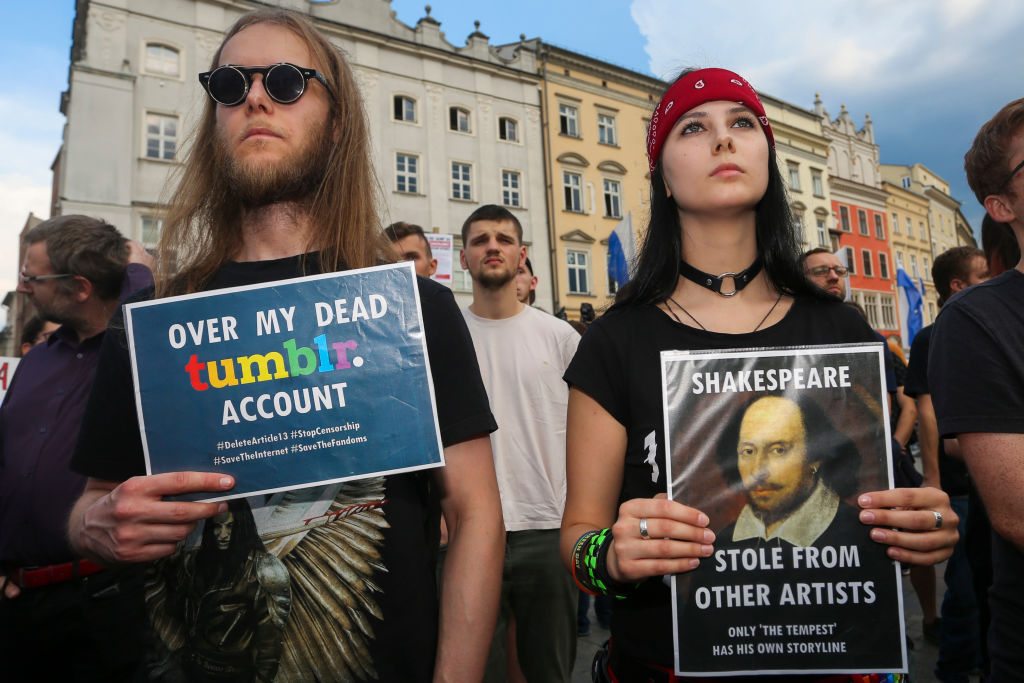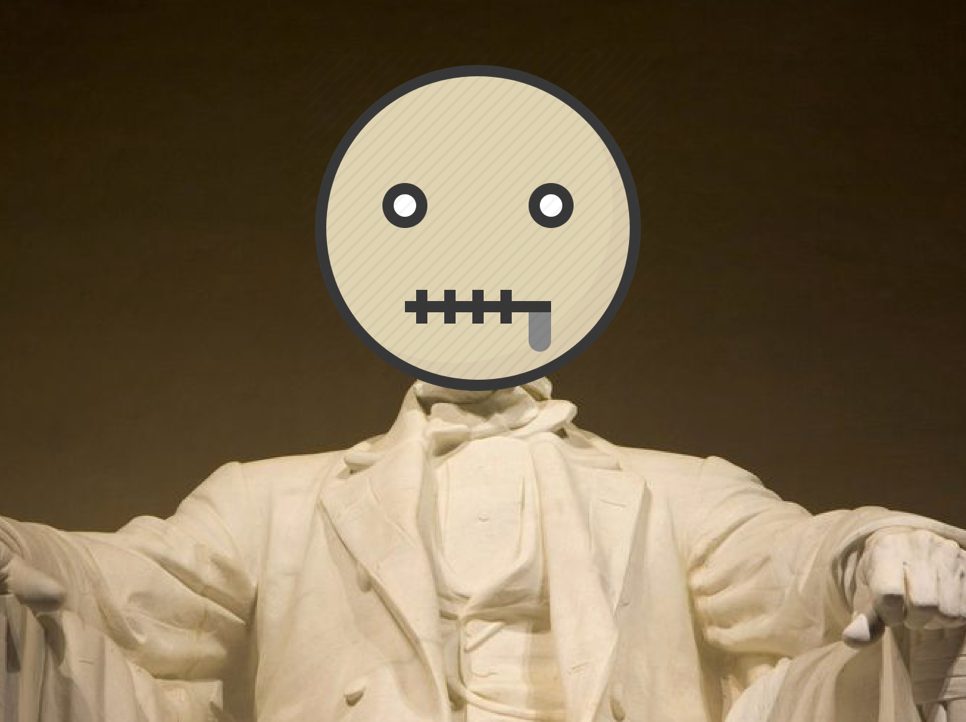Tumblr U.

How “wokeness” arose from the hyper-obsessive, hyper-fragile culture of a half-forgotten platform.
There is a familiar argument that universities have long been incubators for “wokeness,” “multiculturalism,” “political correctness,” and “identity politics”—either since the 1930s or the 1960s, depending on who’s asking—and the snake is finally eating its tail. Universities are being cannibalized by the values they themselves promoted.
It’s easy to find supporting evidence for this argument.
One could point to Peter Thiel and David O. Sacks’ 1994 book The Diversity Myth, which opens with an anecdote about a group of Stanford students led by Jesse Jackson, chanting, “Hey hey, ho ho, Western Civ has got to go,” in an attempt to remove a Western Civilization class from the core curriculum in the service of a more globalized education. The group was successful, and the course was supplanted with “Culture, Ideas, and Values,” which was later scrapped after a curriculum report revealed that 72% of the student body didn’t like it.
You could also point to the myriad surveys, many of which date before the 1970s, that suggest professors are much more likely to identify as liberal, both on campus and relative to other professions. Conventional wisdom says those who identify as progressive are also more likely to support “political correctness,” and one follows the other. And then there’s the obvious bit: Many of the thinkers, writers, and activists whom our social justice-minded friends draw ideas from come from within academia themselves.
It would stand to reason that the values that underpin “wokeness” were transmitted within classrooms and created a monster. The professors write books and papers or are mentored by people who come up with these ideas, they teach them in their classrooms, the students internalize them and start looking for contradictions in their immediate environment. They go out into the workforce; the ideas continue to germinate. The standard line of reasoning is that we’ve been brainwashing the American public for a minimum for fifty years, and we’re finally experiencing the knock-on effects.
It’s an attractive argument; it feels coherent; it names a clear enemy to fight; it gives an implicit blueprint for action. And part of it is even true, some version of “woke” ideology—for lack of a better designation here—has been present on college campuses since at least the 1960s. And again, depending on what you count as part of the heritage of wokeness, you might even be able to argue it’s been going on for much longer than that.
But believable as it all is, I’m left with questions.
Even in the 90s, that new era of multiculturalism that Thiel and Sacks wrote about, universities were still welcoming to eccentric and sometimes radical thought of all varieties. Even academics in the humanities, many of whom are often far left, were not “far left” in the same respect that the Woke Industrial Complex allegedly is.
How many great conservative thinkers were once academics? How many thinkers who defy the left-right binary came from college campuses (many of whom have cult followings)? And if professors in general are more likely to be liberal or moderate, why should it follow that they necessarily subscribe to a radical ideology, or even just one that’s particularly preoccupied with identity, and not more mainstream, standard-issue progressive beliefs like being pro-choice, in favor of higher taxes on the rich, or pro-firearm regulation?
What of the departments that had traditionally remained apolitical, like mathematics, where, if those surveys about professors’ political beliefs are to be believed, the lion’s share of educators are also progressive? And when was the last time you heard about a professor protesting for major departmental reforms, outside of fair payment for their labor?
Many of the complaints about representation or cultural appropriation, the call for trigger warnings, and the censure of problematic voices come from the student body. I wouldn’t be the first to suggest the professors are more afraid of their students than the other way around.
Ultimately, I wonder, did it take that long to indoctrinate people and see visible change? Or did something else latch onto what were once ideas contained to academic and activist circles and catalyze their spread? Were these concepts being re-purposed, and rather than through academic brainwashing, were first spread through other means?
The rise of “wokeness,” and terms and phrases like, “cultural appropriation,” “safe space,” “trigger warning,” and “check your privilege,” tracked approximately to 2011, and really began to peak in 2013.
This dovetailed with some interesting trends. Tumblr, a digital gathering place for activism, fandoms, and the intersection between the two, was among one of the most visited sites on the web for millennials.
According to a tumblr book: platforms and cultures:
Not surprisingly, these fans were nonconforming in other ways as well; Tumblr has been largely dominated by feminist, queer, and activist fans of all ages. Media fandom at large throughout the 2010s was deeply affected by Tumblr’s aesthetics, fan cultures, and community practices, all of which continue to be felt across platforms.
Academia doesn’t exactly pull a crowd, but do you know what does? Media properties like One Direction, the Marvel Cinematic Universe, Supernatural, Steven Universe, and Harry Potter.
Tumblr’s interface made it particularly easy to share and remix content—meaning streams between fandoms and niches was a hallmark of the website. In other words, popular media content that was going to go viral anyway regularly had activist messaging appended to it.
Not only did Tumblr know this about itself, but eventually media companies came to understand it too.
As writers and journalists (it’s worth drawing a distinction between the two) are pressured to produce new content designed to generate clicks, pitching personal essays for $50-100 a pop becomes something of a badge of honor. You have a dual problem of writers needing content and going to increasingly obscure sources to procure it, and people strip mining their own lives for content in the service of having an audience read their “personal essays.”
What do either of these have to do with what the identity politics landscape has become? Both Tumblr and digital publications like Vice, Buzzfeed, Jezebel, Bust, and Rookie (to name just a few) had a much wider reach than academic literature, or even activist groups. You were much more likely to encounter a bastardized interpretation of the meaning of “emotional labor” on your Tumblr feed, or a Vice article regurgitating that Tumblr post, than you were in a classroom.
Once something is trending online, it’s fair game for a struggling publication, particularly if it lends itself to a catchy, clickable title.
Even early news articles about topics like “privilege,” or even “trigger warnings,” reference their ubiquity in online spaces, as opposed to within academic ones.
Take this article 2013 article at The Conversation about trigger warnings. Writer Lauren Rosewarne, a lecturer at the University of Melbourne, describes them as “used mostly on-line to head up discussions of topics like sexual violence, depression or self-mutilation.” It was not a term popular in academia, in activism, nor one that originated in a psychiatric setting for sufferers of PTSD.
If that’s not convincing though, take a look at how people talked about Tumblr back in the 2010s. There are the myriad articles from the 2010s that named the source head on.
There was The New York Times’ “Millennials and the Age of Tumblr Activism.” Forbes, in collaboration with Citibank (wut), published “How Tumblr is Changing Online Activism.” Then there’s this study, from Murray State, which declares a strong relationship between the amount of time spent on Tumblr and one’s concern about certain identity-centric activist topics. Those are just a handful of examples.
Nearly every major publication noticed this shift at the time, as did social scientists, trend forecasters, and even just average people online. There are still-active Subreddits calling out the influence of “tumblrinas,” like /r/tumblrinaction. For a short period in the 2010s, something along the lines of “academic and activist ideas are being re-appropriated and reinterpreted by Tumblr, and then reflected back into a university setting” was a hot topic.
“Keyboard warriors” and to a lesser extent, “political correctness,” were swiftly replaced with “social justice warriors” (both as an adjective and a noun). This later evolved into “woke,” borrowing a decades-old term from AAVE.
In the same respect that certain online spaces didn’t “invent” capital-t Traditionalism, Tumblr didn’t “invent” the variety of identity politics that we now recognize as mainstream. It did, however, reposition and recontextualize it on a platform designed for sharing.
It applied it to popular fandoms, meaning it was more easily transmissible and more accessible to younger audiences. From there, digital subcultures, memes, and trends emerged, making them easy fodder for contributors to online publications to write about, during a time of duress for the industry.
There’s no denying that universities have played an increasingly noisy role in manufacturing woke content and trickling it down into youth culture. But instead of YouTube and Facebook, maybe it was Tumblr we should have been so concerned about all these years.
The American Mind presents a range of perspectives. Views are writers’ own and do not necessarily represent those of The Claremont Institute.
The American Mind is a publication of the Claremont Institute, a non-profit 501(c)(3) organization, dedicated to restoring the principles of the American Founding to their rightful, preeminent authority in our national life. Interested in supporting our work? Gifts to the Claremont Institute are tax-deductible.
Plato shows us who the real tyrants are.
Academics speak out against the threat of censorship.



